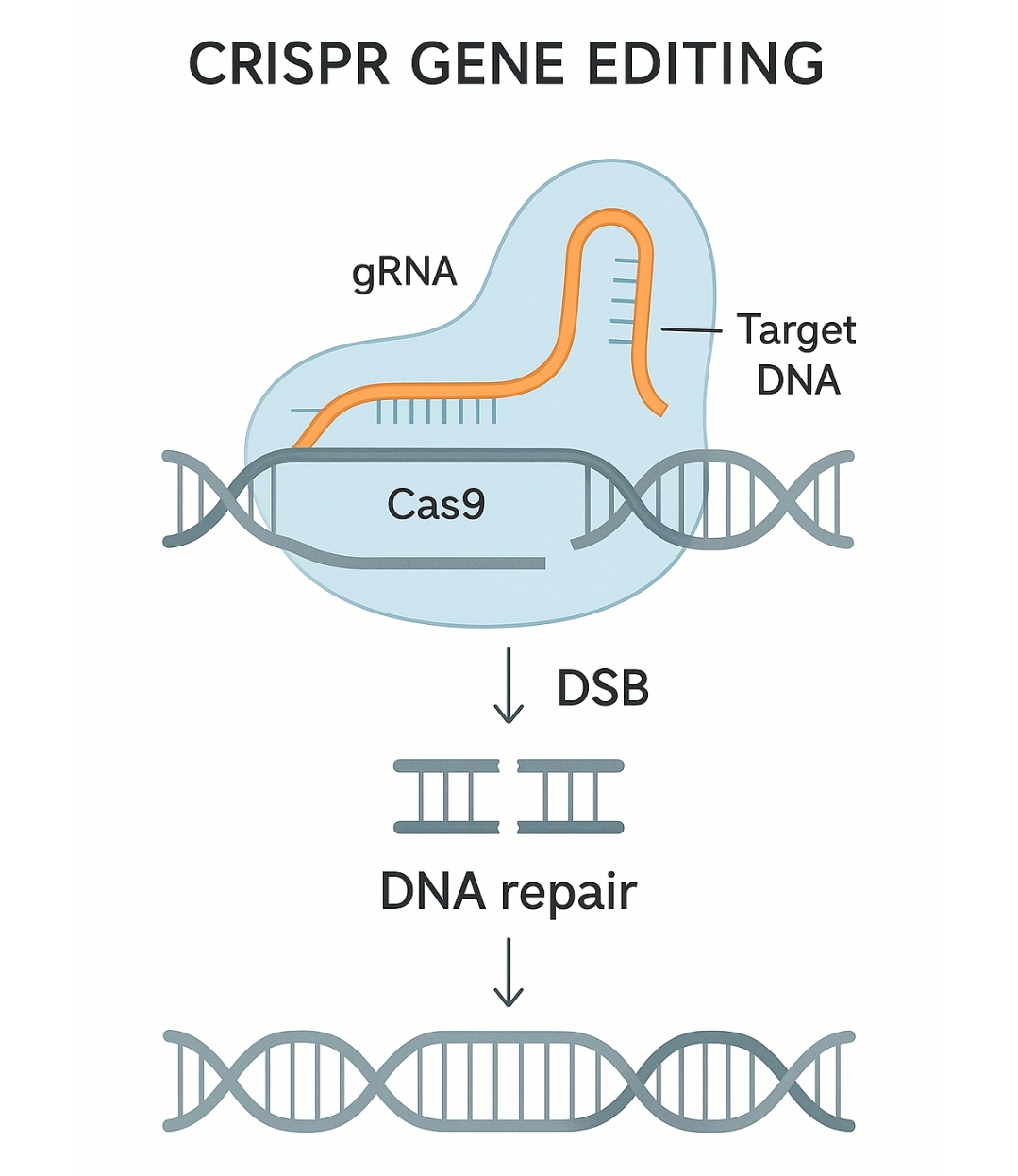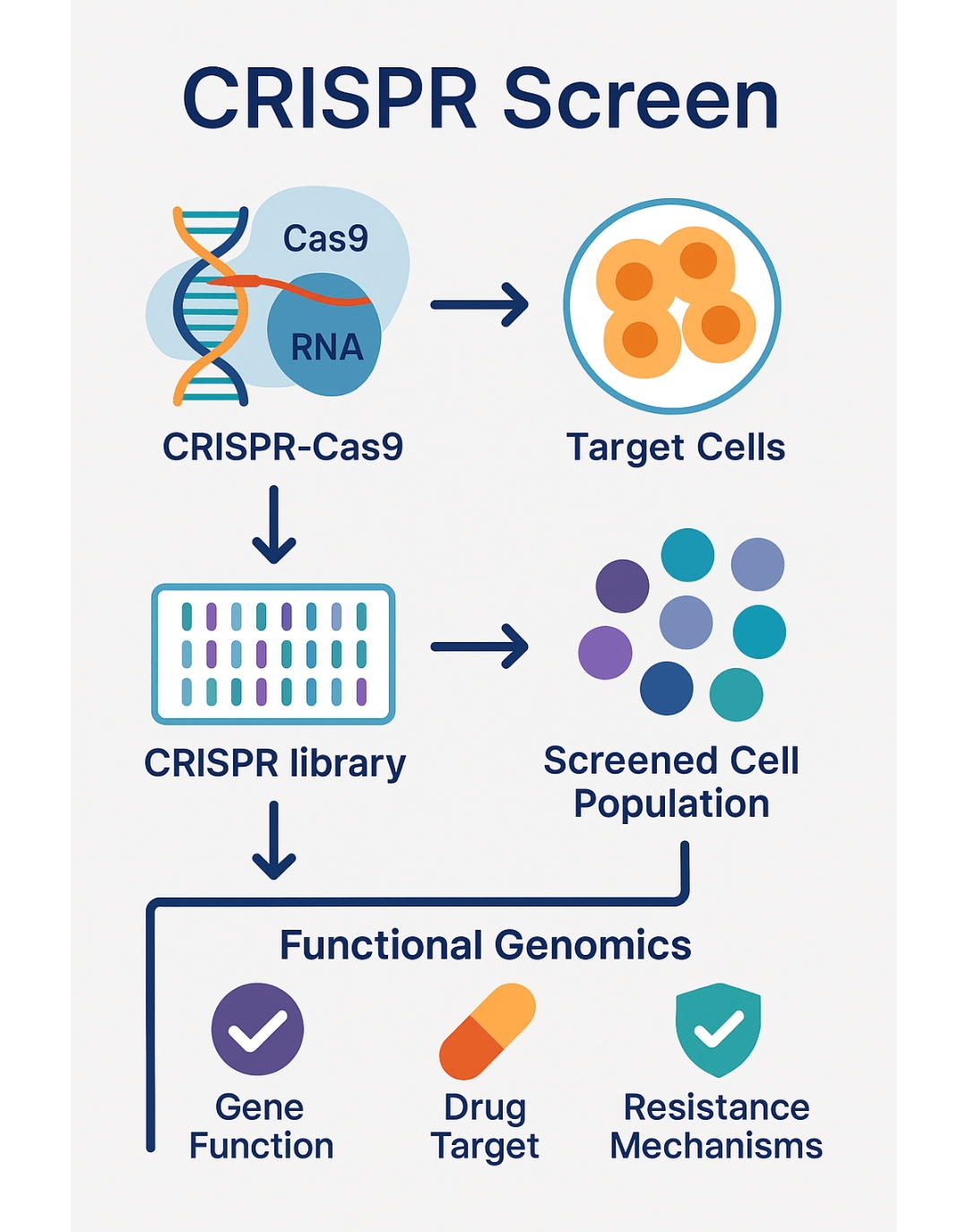Introduction
CRISPR technology has emerged as one of the most transformative tools in modern genomics, fundamentally reshaping how we approach genetic research and therapeutic interventions. At the heart of this revolution are CRISPR gene editing and CRISPR screen—two essential components that have empowered researchers to explore the genetic underpinnings of diseases, discover novel drug targets, and develop innovative treatments. CRISPR gene editing, a precise method for modifying DNA, allows for targeted genetic alterations with unmatched efficiency and accuracy. Meanwhile, CRISPR screens enable high-throughput functional genomics studies, offering unprecedented insights into gene function, essentiality, and complex biological pathways. Together, these technologies are accelerating breakthroughs in understanding the complexities of human genetics and disease, from basic research to potential clinical applications.
What is CRISPR Gene Editing?
Definition and Background

CRISPR gene editing refers to a powerful technique that allows researchers to precisely modify the DNA of living organisms. At the core of this technology is the CRISPR-Cas9 system, a natural defense mechanism originally discovered in bacteria, where it functions to recognize and cut viral DNA. The system works by using a guide RNA (gRNA) to direct the Cas9 enzyme to a specific location in the DNA sequence, where it makes a double-stranded break. The cell’s natural repair mechanisms then kick in, allowing for targeted modifications, such as gene knockouts, insertions, or corrections.
One of the key advantages of CRISPR gene editing over older gene-editing techniques like Zinc Finger Nucleases (ZFNs) and Transcription Activator-Like Effector Nucleases (TALENs) is its efficiency and precision. While ZFNs and TALENs also rely on DNA breaks to induce changes, they are much more complex to design and have lower targeting specificity. In contrast, CRISPR is easier to design, less costly, and capable of targeting multiple genes simultaneously, making it an invaluable tool in research and therapeutic development.
For more information on CRISPR gene editing and its applications, you can click here.
Applications in Research
CRISPR gene editing has opened up new avenues for research across multiple biological fields. In basic biological research, it allows scientists to dissect gene function by knocking out specific genes and observing the resulting phenotypes. This process is particularly useful in model organisms such as mice, fruit flies, and zebrafish, enabling researchers to understand how specific genes contribute to development, disease progression, and aging.
Another major application of CRISPR gene editing is in the generation of animal models for human diseases. These models are essential for studying complex diseases such as cancer, neurological disorders, and genetic conditions like cystic fibrosis. For example, using CRISPR to introduce mutations into the genome of a mouse model can simulate human diseases, providing a powerful platform for studying disease mechanisms and testing potential therapies. These models are crucial for preclinical drug development, as they allow researchers to evaluate the efficacy and safety of new treatments in living organisms before human trials.
The Role of CRISPR Screen in Genomic Discovery
What is a CRISPR Screen?

A CRISPR screen is a high-throughput technique used to systematically study gene function across the genome. By utilizing the CRISPR/Cas9 system, researchers can knock out genes and observe their effects on cellular processes. This method allows for the identification of genes that are essential for survival, drug resistance, and other critical biological functions, offering a more accurate and scalable approach than older methods like RNAi.
For a detailed explanation on how to leverage CRISPR screens in your research, you can check more here.
Types of CRISPR Screens
- Loss-of-function screens:
- These screens knock out genes to identify those critical for cell survival or specific functions. They are used in disease research, such as identifying genes essential for cancer cell survival.
- Gain-of-function screens:
- CRISPRa, or gene activation, is used in gain-of-function screens to overexpress genes and study their effects on cellular behavior, such as promoting cell growth or resistance.
- Advantages over Traditional Methods:
- Unlike RNAi, which can only partially knock down gene expression, CRISPR screens enable complete gene knockout, providing more reliable insights into gene function.
Real-World Applications
CRISPR screens have broad applicability across various research areas, including drug discovery, cancer research, and immunity studies. Some examples of how CRISPR screens are used in research include:
- Cancer Research: CRISPR screens are used to identify drug-resistant genes and potential cancer drug targets by knocking out genes in cancer cells and observing the resulting phenotypes.
- Pathogen Research: CRISPR screens help uncover host factors involved in pathogen infection, offering new avenues for antiviral and antimicrobial therapies.
- Metabolic Studies: Researchers use CRISPR screens to explore genes involved in metabolic diseases, providing insight into potential therapeutic targets for conditions like diabetes.
How CRISPR Gene Editing and CRISPR Screens Work Together
Combining CRISPR Gene Editing with CRISPR Screens
The integration of CRISPR screens and CRISPR gene editing offers a comprehensive approach to understanding gene function and discovering therapeutic targets. CRISPR screens are typically used to identify genes that contribute to specific biological processes or diseases. Once these candidate genes are identified, CRISPR gene editing allows researchers to confirm their roles by creating gene knockouts or knock-ins, which can validate the findings from the screen. This combination ensures that not only are genes identified, but their functions are also thoroughly tested in a controlled environment.
By using both technologies, researchers can conduct large-scale genetic studies while also making precise modifications to target genes, providing deeper insights into gene function and disease mechanisms. For instance, in cancer research, CRISPR screens might reveal essential genes for tumor growth, and CRISPR gene editing can then be used to create cell models that directly test these targets for drug sensitivity or resistance.

Impact on Precision Medicine
The synergy between CRISPR screens and CRISPR gene editing has significant implications for precision medicine. By identifying genetic mutations or variations that influence disease susceptibility and treatment response, these technologies can help tailor therapies to an individual’s unique genetic makeup. For example, CRISPR screens can identify genes linked to drug resistance, and CRISPR gene editing can be used to explore how these genes function in different genetic backgrounds, leading to more personalized and effective treatment strategies.
The Future of CRISPR Technology
Advancements in CRISPR Gene Editing
The future of CRISPR gene editing lies in emerging technologies like prime editing and base editing. These innovations allow for more precise genetic modifications, with fewer off-target effects, making gene editing safer and more efficient. Such advancements could expand the therapeutic potential of CRISPR, offering new avenues for treating a broader range of genetic disorders.
Challenges and Ethical Considerations
Despite its progress, CRISPR technology faces several challenges. One of the main concerns is the issue of off-target effects, where unintended sections of the genome are edited, potentially leading to harmful mutations. While progress has been made in improving targeting accuracy, this remains a challenge for both CRISPR gene editing and CRISPR screens.
Ethical concerns also accompany the growing use of CRISPR in human gene editing. Questions regarding the potential for germline editing (modifying human embryos) raise significant ethical issues related to the long-term impacts on the human gene pool, as well as the possible unintended consequences of altering genes in future generations.
The Future of CRISPR Screens
CRISPR screens are also advancing rapidly. Single-cell CRISPR screening is an emerging technology that allows researchers to examine gene function at the level of individual cells, providing a more detailed understanding of cellular heterogeneity. This could prove crucial in studying complex diseases, such as cancer, where tumor cells exhibit vast genetic and phenotypic diversity. As CRISPR screens continue to evolve, they are expected to become more precise and capable of identifying even more intricate gene interactions and networks.
Conclusion: Unlocking New Frontiers in Genomics with CRISPR
In conclusion, CRISPR gene editing and CRISPR screens are two powerful technologies that have already made significant contributions to our understanding of genetics and disease. Together, they form an essential toolkit for researchers, enabling high-throughput gene discovery and precise genetic modifications. As these technologies continue to advance, the potential for breakthroughs in both basic science and therapeutic applications grows exponentially. By combining CRISPR gene editing with CRISPR screens, scientists are unlocking new frontiers in genomics that will lead to more targeted therapies and improved precision medicine.
As we look to the future, it is clear that CRISPR technology will continue to shape the landscape of genomics and biotechnology, opening up new possibilities for medical treatments and scientific discoveries.




























